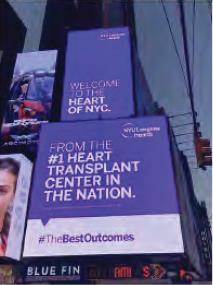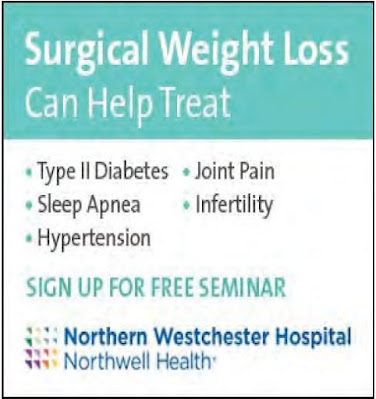NYU Langone Health Sys. v. Northwell Health, Inc., 2024 WL 898941, No. 23-CV-5032 (VEC) (S.D.N.Y. Mar. 1, 2024)
NYU Langone sued
Northwell for trade dress infringement, unfair competition and false
designation of origin, and false advertising under the Lanham Act, as well as
related claims under the New York GBL and New York common law. The core
allegation is that Northwell copied its advertising to trade off the good will
and reputation of NYU Langone. The court dismissed the complaint—the false
advertising claims with prejudice.
The parties are both
nonprofit health systems in New York and advertise to the same market, with NYU
Langone having recently expanded its presence on Long Island, where Northwell
is headquartered.
NYU, including NYU Langone and other subsidiaries, has used the color purple in its signage and branding for over 100 years. NYU Langone’s 2017 style guide suggests the distinct shade of purple be “prominently feature[d]” with white font and accent colors like teal and orange, like so:
 |
NYU Langone alleged
the existence of advertising trade dress (e.g., teal and orange) and photos,
... [and the] use of purple, white, and accent color combinations in words and
phrases in the ad headlines.”
Before 2019,
Northwell advertisements allegedly featured a logo with blue letters and
multicolored arrows on a white background:
 |
In 2021, Northwell’s advertisements allegedly changed and now use white letters and arrows on a purple background:
NYU Langone failed to adequately allege a protectable trade dress. “To state a claim for trade dress infringement, a plaintiff must first clearly articulate the design or combination of features that make up the trade dress. The articulation must provide a ‘precise expression of the character and scope of the claimed trade dress.’” Clarity and specificity are “imperative because courts cannot ‘shape narrowly-tailored relief if they do not know what distinctive combination of ingredients deserves protection.’” Further, “[t]rade dress descriptions with too many possible combinations are not specific enough to state a claim.”
The allegations here
were
confusing and expansive. The Complaint provides a laundry list of
elements, some introduced by “e.g.” and some connected by “or,” that
encompasses such a wide variety of features that it would be difficult for
competitors to know whether their advertisement falls within the trade dress.
NYU Langone defines its trade dress as follows:
the prominent use of a distinctive purple color, the use of particular
accent colors (e.g., teal and orange) and photos, specific font types, colors
and headline styles (i.e., all cap sans serif white headlines, as well as white
font with certain words and phrases emphasized in the same or similar accent
colors), use of purple, white, and accent color combinations in words and
phrases in the ad headlines, and specific layouts in terms of placement and use
of accent colors, all of which create a distinctive look and feel.
Photos in the complaint
of the alleged trade dress “vividly illustrate how features such as font,
color, and layout vary across ads. Even among ads that are predominantly
purple, the shade of purple varies; some have all cap white writing; some have
all white sentence case writing; and some have a mix of white and other color
writing.”
Other ads had “just
a splash of purple”:
Some ads were split between photos and text, with the text varying in color and case and with the split sometimes being vertical and sometimes horizontal:
The court couldn’t identify specific fonts, colors, or headline styles that were part of the trade dress, other than that they were sans serif fonts. “Categories of features” were insufficient.
The current
definition was too general, contained too many “or” connectors and “for
example” phrases, and “overall encompasse[d] too many possible permutations and
combinations to constitute a singular distinct trade dress,” though the court
would allow an amended complaint.
False advertising: NYU
Langone alleged that a Northwell ad falsely claimed that one of its hospitals
“is NYC’s only hospital in the Nation’s Top 50” and “offer[s] the best care in
Manhattan.” This claim was based on rankings from Healthgrades and included the
Healthgrades logo directly underneath the claim. NYU Langone alleged that
Healthgrades’ rating methodology lacks transparency and relies on inaccurate
and incomplete reporting, and that the claim was false because U.S. News &
World Report ranked NYU Langone “#1 in New York State and in the New York City
Metro area” in its “Best Hospitals Honor Roll.”
 |
| ad as described with Healthgrades logo on bottom |
The statement that Lenox Hill is the only NYC hospital in the Nation’s Top 50 wasn’t literally false because Northwell cited the Healthgrades rating. Questioning Healthgrades’ underlying rating methodology didn’t falsify the claim that Lenox Hill was the only NYC hospital rated in the Top 50 in that particular list.
Nor did NYU Langone
sufficiently allege misleadingness. It was not enough to allege only that “Northwell’s
false or misleading statements actually deceived or have the tendency to
deceive a substantial segment of consumers.” “While proof of confusion is not
necessary at the pleading stage, factual allegations that would allow the Court
plausibly to infer that the advertisement caused confusion are. NYU Langone’s
single conclusory sentence is insufficient.” And “best care in Manhattan” was
puffery.
Under NYGBL § 350,
“a disclaimer or similar clarifying language” can defeat a claim of false
advertising as a matter of law, and the Healthgrades rating did so here.
Amendment would be
futile because no reasonable jury could conclude that consumers were misled or
confused by an add bragging about Lenox Hill’s Healthgrades rating and boasting
that it offers the “best” care in the city. “Consumers are familiar with this
common type of advertising, in which businesses tout that they are the best
according to some newspaper, magazine, blog, Yelp or Google review, poll, or
other rating system.” In fact, NYU Langone does the same:
Both of these claims can be true.

















No comments:
Post a Comment